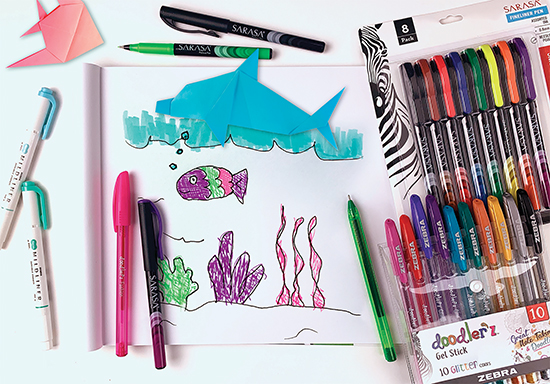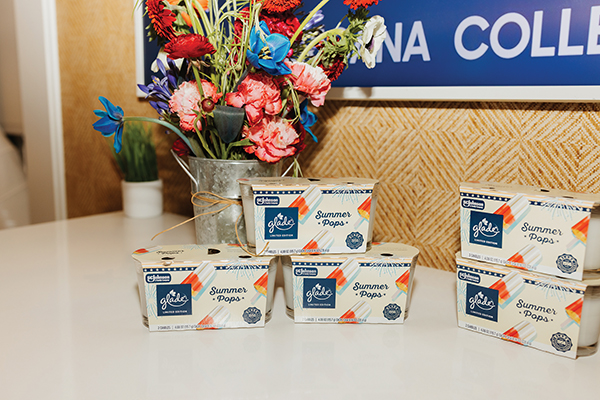Live Better
Creating memorable family moments together


Educational activities ideal for making memories together
(Family Features) Educational activities and plans that allow kids to flex their brain muscles in fun and creative ways can be ideal ways to spend family time that makes lasting memories.
While children typically gain invaluable knowledge and experience in the classroom, purposeful activities done outside of that setting can help encourage kids to keep learning and make family moments more enjoyable for everyone involved.
From planning trips that celebrate animals and the great outdoors to rainy day activities at home that inspire creative expression, these ideas can produce some family moments worth remembering.
1. Go on a scavenger hunt. From native species of plants, animals and insects to neighborhood landmarks, there are plenty of interesting things that can be found right in your own backyard. Organize a scavenger hunt and work together in teams of family members to search for each item on the list, then do more research on the things you found once you return home. For a real challenge, expand your hunt to the city limits of your hometown and make a day trip of the adventure.
2. Hang out with wildlife. Learn about different species of animals, how to help protect them and the importance of eco-friendly everyday practices by visiting a destination like an Association of Zoos and Aquariums (AZA)-accredited zoo or aquarium. You can explore the challenges facing endangered species, discover how community programs are spurring positive change for conservation and learn more at aza.org. After learning about animals that need help, you can visit zebrapen.com/aza for fun kids games, coloring pages and other activities that encourage creativity. Many animal sanctuaries and wildlife recovery centers also have endangered species and offer educational information about them.
3. Visit a national park. Many park ranger programs provide opportunities to interact with the animals that live in the area, as well as information about any endangered animals and how you can help with conservation efforts. While in the park, you can also enjoy a nature hike, have a picnic lunch and view the different species of plants in the region.
4. Enjoy an arts and crafts day. Spending time doing an art project is a hands-on way to help introduce kids to new ideas and ways of learning. Engage the entire family by creating crafts with different subjects of interest. This can help create conversations and opportunities to further explore what your children are interested in.
5. Organize a game day. A play day can be just as fun as it is educational. Choose from a variety of games that can allow players to get extra creative. Options like Pictionary or charades tap into different types of creative skills, which can keep everyone engaged while they’re learning to express themselves effectively in new ways.
Capture Moments That Matter

Make your family’s learning adventures more memorable by encouraging kids to capture their experiences on paper. The practice of communicating on paper can help lock in memories, plus it’s a clever way for kids to practice practical skills in an engaging and productive way.
Adjust these ideas as needed to match the ability level of each child so the whole family can participate.
1. Write about experiences in a journal or diary. For older kids, encourage them to use words to describe their adventures. Ask younger kids to draw a scene or image that captured their attention or excited them the most.
2. Design a diorama about your family’s adventures to display in your home to show extended family and friends. Make it a conversation piece by asking kids to think about an endangered species and depict its living environment. Available in standard, glitter, neon, metallic and pastel colors, tools like Zebra Doodler’z® allow little designers to explore the nearly endless possibilities for color coding, sketching, journaling and embellishing.
3. Take photos to share with friends and family both online and in-person. Get creative with your photo-taking by encouraging kids to think about the story they’ll tell through the images. It might be a series of selfies tackling exciting new activities or documenting a sibling’s first experience at the petting zoo. Another way to capture photographic memories is a photo treasure hunt, where kids have a list of items to search for and photograph during each outing.
4. Create a family calendar to plan your summer activities together. Anticipating upcoming adventures is part of the fun. Let kids help you keep track of what’s coming up and build excitement with a personalized calendar. Make it a work of art by asking kids to draw icons or small images that depict upcoming activities with an option like Zebra’s Sarasa® Fineliner Pens, which are available in 12 vibrant colors.
5. Share experiences on social media. Let friends and family in on the fun by sharing your photos, drawings, dioramas and other creations online. Seeing the positive interaction and praise-filled comments from loved ones can help reinforce the value of creative expression to impressionable young minds.
6. Create scrapbooks to help remember family moments. Keep the pace of life from fading those precious memories by assembling scrapbooks to commemorate family adventures. Make the scrapbook a family affair with everyone contributing their own creations.
Find more ideas for capturing and sharing experiences at zebrapen.com.
Photo courtesy of Getty Images (children at aquarium)
SOURCE:
Zebra Pen
Live Better
Laying the foundation for writing

(Family Features) Learning to write is one of the defining milestones of early childhood, but it doesn’t happen all at once. Children build writing skills over time, from indecipherable scribbles to writing letters and words. While children progress at their own pace, families can help foster early writing development.
Dr. Lauren Loquasto, senior vice president and chief academic officer at The Goddard School, and Dr. Sonia Cabell, professor of reading education at Florida State University and member of The Goddard School’s Educational Advisory Board, provide this insight and guidance for families.
Early Writing Milestones
Writing begins in early toddlerhood, around 18-24 months. The earliest developmental milestone is when children scribble on paper with a crayon.
By 2-3 years old, children often draw shapes and narrate their writing. Parents should show genuine interest to help build confidence and interest. Ask your children to read what they write, as this helps make the connection that marks on paper represent thoughts and ideas. It’s not expected for children younger than 3 to write identifiable letters. Instead, encourage them to make marks on paper without constraint, allowing them to freely express themselves.
Around ages 3-5, children begin to move from writing (making marks) to handwriting, which is the formalized motion of making numerals and letters in recognizable forms. It’s vital for parents to value their children’s writing no matter what appears on the paper and provide opportunities for them to regularly engage in writing. Children at this age tend to write letters in different ways. It’s common, for example, for letters to appear backwards or from right to left. These are not causes for concern; this is a natural part of the development process.
Writing Supports Reading (and Vice Versa)
Reading and writing skills develop in tandem, reinforcing each other. Through writing, children experiment with how written language works, learning English moves from left to right and top to bottom. By estimating spelling – using their knowledge of letter shapes and sounds to attempt to write words – they are beginning to break the code of reading. Moreover, when children are composing stories, they are supporting comprehension and oral language growth, which are critical for reading development.

Encourage Writing at Home
Make writing part of everyday life. While ensuring paper and writing utensils are accessible is a start, materials alone won’t spontaneously create writing experiences. Children naturally want to engage with things they see, so parents and older siblings should serve as writing models. For example, when writing a grocery list, ask your children to write their own lists. When you’re writing a thank-you note, have them write their own.
The development of fine motor skills is also essential. One way to do this is provide tools like chopsticks or tongs that require them to use their forefinger and thumb in a pinching motion; this strengthens the hand muscles that are used to write. Also encourage play with small toys like blocks or beads that engage the hands in different ways. As fine motor skills improve, it becomes easier to grip writing utensils and write for extended periods.
Writing Tools
From apps to workbooks, countless tools and resources tout their ability to help children learn to write. Be wary. Typing on a tablet or computer is no substitute for learning to write by hand. Multiple studies have shown that writing – not typing – better promotes cognitive and literacy development.
Avoid activities like workbooks that require repetitive writing of letters over and over, as this inhibits creativity and experimentation. These activities can cause children to fear making mistakes, which can lead to anxiety, frustration and a loss of interest. The best tools are often the simplest: a small writing utensil (not big or bulky; children have small hands and need appropriately sized utensils) and a blank piece of paper.
Remember, children develop at their own pace. Provide encouragement and focus on effort, not perfection.
To watch a writing webinar featuring Loquasto and Cabell and access additional parenting resources, visit the Parent Resource Center at GoddardSchool.com.
Photos courtesy of Shutterstock
SOURCE:
Live Better
Keep your summer entertaining simple, fun

5 expert ways to make the most of seasonal gatherings
(Family Features) From summer holidays and pool parties to spontaneous backyard barbecues with friends and neighbors, the hottest season of the year brings people together. When it’s your turn to host, make the most of the occasion by setting up your space to maximize the fun while showing off your festive side.
“Summer is hands down my favorite time to host,” said Kristina Zias, lifestyle, beauty and fashion expert and mom. “I love any excuse to bring people together and – let’s be real – I’m always looking for a reason to throw a party. The key is keeping things low stress for the host and making sure guests feel comfortable the second they walk in.”
This season, Zias and Glade are teaming up to share some of her favorite summer entertaining tips, which are simple, low-effort ways to make every gathering feel special. Whether you’re planning a full-blown backyard bash or hosting a few friends for drinks, Zias’ go-to ideas are all about setting the mood and enjoying the moment.
1. Set the Scene Without the Stress
To achieve a beautiful scene and make cleanup a breeze, try using disposable plates, utensils, napkins and cups in red, white and blue. A self-serve drink station with strawberry-infused water and a table of colorful fruit skewers adds charm without requiring much prep.

2. Tap Into Nostalgia Through Scent
Scent can instantly transport guests back to cherished summer memories, making it a powerful way to set the tone and spark conversation. Zias suggests using home fragrances to do just that. The new Glade Americana collection, available exclusively in stores and online at Walmart, features three limited-edition scents inspired by nostalgic summer traditions like beach trips, ice pops and garden-fresh fruit. Masterfully crafted to help bring summer to every room of your home, they’re designed to evoke warm-weather traditions.
- Berries & Cream: Scents of a classic American summer treat spring to life in a picnic-perfect blend of apple, red berries, apricot, vanilla and sweet cream.
- Summer Pops: Reminisce on childhood memories of a cool ice pop on a warm summer day with bright notes of Brazilian orange, pineapple, strawberry, white peach and sandalwood.
- Beach Life: Transport yourself to a favorite summer vacation spot by the ocean with a breezy mix of sea salt, driftwood, white moss and white peony.
“These seasonal scents can help you evoke nostalgic memories and bring that summer energy into any room of your home,” Zias said. “They make everything feel a little more special and, honestly, they just make me happy.”
3. Keep It Simple and Guest-Friendly
Part of summer’s appeal is its easygoing vibe, so there’s no need to overdo it with complicated snacks or overwhelming decor. Lean into the simplicity of the season with ready-to-serve bites that can please guests of all ages, like berries, sliced or cubed watermelon, meat and cheese trays, sliders or chips and light dips. A separate kids station with games and snacks can keep little ones entertained.
4. Create Comfortable Hangout Spots
The hot summer sun and cool indoor air means guests will likely filter in and out of the house, so help them feel welcome and comfortable wherever they may be. Consider flexible seating guests can move around on the patio or in the yard, like bag chairs or foldable lawn chairs. Complement your festive indoor drink station with beverage-filled coolers to keep guests refreshed and designate an area for essentials like sunscreen and bug spray.
5. Have a Backup Plan
The best-laid plans can go awry when summer storms pop up. Before inviting the entire town for a barbecue, make sure you have enough indoor space and seating in case of rain or extreme heat. For grilling plans, Zias recommends prepping an alternate cooking method to avoid last-minute stress. A little backup planning can help keep the good vibes going, rain or shine.
For more summer entertaining ideas, visit Glade.com.
Photo courtesy of Shutterstock (group of friends eating)
Photo courtesy of Glade (candles)
SOURCE:
Live Better
Physical movement can help fight chronic diseases

Physical activity is a valuable tool in the fight against chronic disease and other conditions. In fact, the Cleveland Clinic highlights physical activity among its nine ways to prevent disease in an effort to live a long and rewarding life.
Children, adolescents, young adults, and even men and women in middle age may not face too many physical hurdles when they try to exercise, but seniors are not always so lucky. Aging men and women with mobility issues may wonder if they can reap the rewards of physical activity, and thankfully there are many ways to exercise even if getting up and going isn’t as easy as it might have been in years past. Sometimes referred to as “aerobic exercise” or simply “cardio,” cardiovascular exercise is an umbrella term that encompasses a wide range of physical activities that raise the heart rate and improve endurance. Seniors with mobility issues can look to various forms of cardio for inspiration as they seek to be more physically active without compromising their overall health.
· Walk your way to a healthier you. Walking is a form of cardiovascular exercise that is ideal for older adults with mobility issues because it need not be physically demanding and it’s safe to walk just about anywhere. Walking in a place such as a local park can be particularly good for older adults because they can take periodic breaks on benches if aches, pains or stiffness is affecting their ability to keep moving.
· Take up swimming. Swimming might be tailor-made for seniors with mobility issues because it’s a great workout and exercising in water tends to be less taxing on muscles and joints. The Cleveland Clinic notes that swimming promotes heart health, strengthens the lungs, helps to burn calories, and builds muscle, among other benefits. And many seniors find swimming is just as fun in their golden years as it was in their youth, which means aging adults might not face problems with motivation when the time comes to get in the pool.
· Use an exercise bike or portable pedal exerciser. Cycling is a wonderful exercise but one that seniors with mobility issues may feel is no longer possible. If doctors advise against riding a traditional bike, an exercise bike or portable pedal exerciser can provide many of the benefits of cycling without as great a risk for accident or injury. A portable pedal exerciser can be carried to a park, where seniors can still spend time in the great outdoors, which is one of the most appealing reasons to get on a bike and go.
· Take beginner yoga or tai chi. HelpGuide.org notes that gentle yoga or tai chi can help to improve flexibility and reduce stress and anxiety. Though yoga and tai chi can provide as much demanding physical activity as individuals allow, beginner classes in each discipline don’t require much movement but do provide enough for seniors hoping to be less sedentary.
Even seniors with mobility issues can find safe and effective ways to be more physically active. Prior to beginning a new exercise regimen, seniors with mobility issues are urged to discuss activities with their physicians.
-

 NEWS3 years ago
NEWS3 years ago2 hurt, 1 jailed after shooting incident north of Nocona
-

 NEWS2 years ago
NEWS2 years agoSuspect indicted, jailed in Tia Hutson murder
-

 NEWS2 years ago
NEWS2 years agoSO investigating possible murder/suicide
-

 NEWS2 years ago
NEWS2 years agoWreck takes the life of BHS teen, 16
-

 NEWS2 years ago
NEWS2 years agoMurder unsolved – 1 year later Tia Hutson’s family angry, frustrated with no arrest
-

 NEWS2 years ago
NEWS2 years agoSheriff’s office called out to infant’s death
-

 NEWS2 years ago
NEWS2 years agoBowie Police face three-hour standoff after possible domestic fight
-

 NEWS3 years ago
NEWS3 years agoDriver stopped by a man running into the street, robbed at knifepoint






